Zachaeus K. Adeyemo, Abraham O. Oyerogba, Isaac A. Akanbi
Electronic and Electrical Engineering Department, Ladoke Akintola University of Technology, Ogbomoso, Nigeria
Correspondence to: Zachaeus K. Adeyemo, Electronic and Electrical Engineering Department, Ladoke Akintola University of Technology, Ogbomoso, Nigeria.
| Email: |  |
Copyright © 2015 Scientific & Academic Publishing. All Rights Reserved.
Abstract
Transmission of multimedia signals over Rician fading channel in wireless communication is faced with different challenges such as noise, delay and impairment which make the multimedia signal unreliable. The conventional methods such as Automatic Repeat Request (ARQ), Reed Solomon code (RSC) and Forward Error Correction (FEC) which are used in combating these challenges are characterized by high complexity and are frequently used over Rayleigh fading channel. Therefore, this paper aims at investigating the effect of Turbo Code in correcting errors which are associated with 3G wireless systems over Rician fading channel. A JPEG-format image and Random binary data are used as the information to be transmitted. The image data is encoded, compressed and passed through turbo encoder. The signals are modulated using BPSK modulator and transmitted over Rician fading channel with Rician factor k =10. The Turbo decoder consists of two decoders separated by interleaver to process the corrupted signal, demodulate and decode to obtain the reconstructed signals. The system is evaluated using Bit Error Rate (BER), Peak Signal to Noise Ratio (PSNR), and Mean Square Error (MSE) to determine the performance. The results obtained show that the BER and MSE of the transmission with Turbo code have relatively lower values compared to the transmission without Turbo code. Also PSNR values of the system with Turbo code have higher values than without Turbo code at any SNR. This has shown the effectiveness of Turbo code in wireless system over Rician channel.
Keywords:
JPEG, FEC, Turbo Code, BER, MSE, PSNR, Rician fading
Cite this paper: Zachaeus K. Adeyemo, Abraham O. Oyerogba, Isaac A. Akanbi, Investigation of the Effectiveness of Turbo Code in Wireless System over Rician Channel, International Journal of Networks and Communications, Vol. 5 No. 3, 2015, pp. 46-53. doi: 10.5923/j.ijnc.20150503.02.
1. Introduction
Wireless transmission is a process of sending multimedia signals from a source to the destination without physical connection. Different transmission rates, dedicated transmission techniques and powerful end user devices are the factors responsible for reliable transmission of signal through different generation of networks such as 2G and 3G known as second and third generation respectively. In this transmission, high errors occur as a result of the distorted signal due to impairment in the wireless channel [1], [2].Third generation (3G) has significantly boosted network capacity to enable operators to support more subscribers, as well as offer more sophisticated services and finds application in wireless voice telephony, mobile Internet access, fixed wireless Internet access video calls and mobile TV. It also supports services that provide an information transfer rate of at least 200 k bit/s. Later 3G releases often denoted 3.5G and 3.75G also provide mobile broadband access of several ‘M’ bit/s to smart phones, but their transmission over 3G wireless systems from a source to the destination cause the high error which makes the received signal to be distorted [1].Joint Photographic Experts Group (JPEG) by multimedia signal is compressed for suitable transmission. This is carried out because it uses 8×8 block Discrete Cosine Transform (DCT) code, so the errors are detected and concealed at the 8×8 block level. Compression is employed to make files smaller, allowing for faster downloading and copying less storage space [3], [4].There are several approaches in the transmission of multimedia signals such as channel coding approach, the error resilience approach and the different detection and correction approaches, but some of them suffered from high complexity which increase the bit error rate [1], [5]. Though, some of the error control techniques have been studied, yet some of their characteristics are still not well understood over different channels in the correction of error caused by the channel. This paper investigates the effect of the turbo code over Rician channel in 3G system. This is due to its powerful codes that occur within a Shannon capacity limit.The system model is developed using turbo code. The model consists of JPEG image and random data which served as input to the DCT compression, encoded and passed through encoder 1, interleaver and encoder 2 before modulating using BPSK signalling scheme. The modulated signals after filtering passed through the Rician channel of factor 10 and decoded by turbo decoder, then demodulated to obtain image and data which are then compared with the transmitted signals to evaluate the performance in terms of BER, MSE, PSNR and image quality.
2. System Model
The system model for transmission of multimedia signal in 3G system using turbo code is developed in Figure 1. The sources to the system model are JPEG image and random data. Discrete Cosine Transform (DCT) compression, JPEG encoder, turbo encoder are at the transmitter; turbo decoder, JPEG decoder, adaptive median filter, DCT decompression and reconstructed JPEG image data are also at the receiver to process the signals. The transmitted signals modulated using BPSK scheme are passed through Rician Channel of Rician factor 
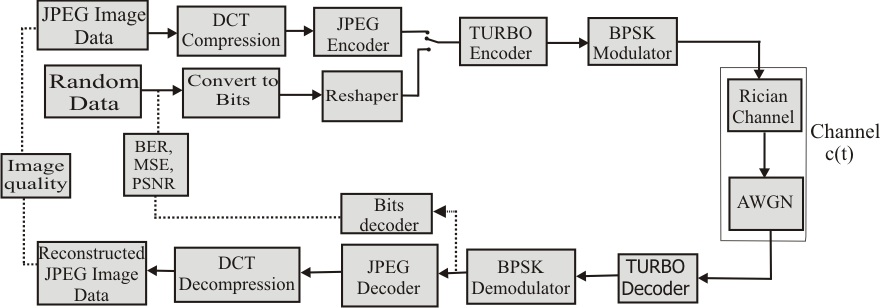 | Figure 1. Simulation model for the technique |
The transmitted image data is in Joint Photographic Experts Group (JPEG) format because it is designed for 8x8 pixel DCT suitable for transmission. The image is read in MATLAB with the imread() function. The read image is in form of integer values between 0 and 255. The DCT compression is performed by taking the discrete cosine transform (DCT). The input image is divided into 8×8 pixel blocks with each block transformed using DCT, and the image is then decomposed into a series of binary images.The JPEG encoder then codes the Direct Current (DC) and Alternating Current (AC) coefficients of the transformed image to reduce redundancy due to correlation between pixels of adjacent blocks; it predicts only the DC coefficient. For intra block redundancy, it only quantizes the DCT coefficients and does not use predictive coding, thereby, explored spatial redundancy at the block level and not at the pixel level. Consequently, the JPEG algorithm left some spatial redundancy unexplored. Figure 2 shows the flowchart of the process. | Figure 2. Flow Chat of the process |
The received signal  through the Rician channel is expressed as
through the Rician channel is expressed as | (1) |
where: is the received signal
is the received signal is the BPSK modulated transmitted signal
is the BPSK modulated transmitted signal  is the Rician channel
is the Rician channel  is the AWGN
is the AWGN
3. Error Control Technique
3.1. Forward Error Correcting (FEC) Technique
Forward error correction coding is used in this work to enhance the efficiency and accuracy of information transmitted. Let  is the number of sent bits and the FEC system adds
is the number of sent bits and the FEC system adds  redundancy bits, therefore making a total of
redundancy bits, therefore making a total of  bits sent through the transmission channel [6]. The redundancy helps the receiver to detect any error inside the received data, depending on the FEC algorithm receiver can correct the error by removal, even when a number of error is introduced during the process of transmission. Since the receiver will not ask sender for retransmission of data without querying the sender for more information, this is why it is called Forward Error Correction technique. In general, the more parity bits generated per data bit, the more potential errors can be detected and corrected [7].
bits sent through the transmission channel [6]. The redundancy helps the receiver to detect any error inside the received data, depending on the FEC algorithm receiver can correct the error by removal, even when a number of error is introduced during the process of transmission. Since the receiver will not ask sender for retransmission of data without querying the sender for more information, this is why it is called Forward Error Correction technique. In general, the more parity bits generated per data bit, the more potential errors can be detected and corrected [7].
3.2. Turbo Code
A turbo code is the parallel concatenation of a number of Reed-Solomon Code (RSC). It is a convolutional type of error correction. The input to the second decoder is an interleaved version of the first decoder, thus the outputs of coder 1 and coder 2 are time displaced codes generated from the same input sequence. The input sequence is only presented once at the output. The outputs of the two coders may be multiplexed into the stream giving a rate  code, and punctured to give a rate
code, and punctured to give a rate  code [8], [2].The encoders take the same data pool as input with bits ordered differently inside this data pool. At the receiver, the decoding parts use the same number and types of FEC components, placed identically. As each decoder has its own view angle and redundancy of the data, one decoder may correct some errors that other decoders have not be able to correct and vice versa. The key point of turbo code architecture is that each decoder sends its corrections to next decoder. The last decoder sends its corrections to the first one, involving an incremental and recursive correction process [9], [10], [11] [12].
code [8], [2].The encoders take the same data pool as input with bits ordered differently inside this data pool. At the receiver, the decoding parts use the same number and types of FEC components, placed identically. As each decoder has its own view angle and redundancy of the data, one decoder may correct some errors that other decoders have not be able to correct and vice versa. The key point of turbo code architecture is that each decoder sends its corrections to next decoder. The last decoder sends its corrections to the first one, involving an incremental and recursive correction process [9], [10], [11] [12].
3.3. Turbo Encoder
The Turbo coder is used for channel coding and achieved by interleaving input bit with recursive convolutional codes. In a simplified turbo code, there are two convolutional encoders. The information bits are scrambled before entering the second encoder. The code word in a turbo code consists of the input bits, that is, the code is systematic, followed by the parity check bits from the first encoder and then the parity bits from the second encoder, as depicted in Figure 3. In general, one can have multiple turbo encoders with more than two branches. The problem of terminating both encoders simultaneously seems to be difficult because of the interleaver.  | Figure 3. Block diagram of a generic encoding process for turbo code |
3.4. Turbo Decoder
At the receiver, the image is demodulated with its associated error and a soft output provided to the decoder. Receiver has two decoders, one after the other encoder. Decoding is done in an iterative process where the decoders use feedback to share information with each other after completing each iteration process. Each component decoder accepts “soft” a priori info and output “soft” a posteriori info (SISO). Four iterations are performed in this study. The first decoder decoded the signals and then passed the hard decision together with a reliable estimate to the next decoder. Then, the second decoder has extra information for the decoding. This is shown in Figure 4. | Figure 4. Block Diagram of Turbo Decoder |
Additional coding gain is achieved by sharing information between the two decoders in an iterative fashion. This is achieved by allowing the output of one decoder to be used as a priori information of the other decoder. Each decoder estimates the A Posteriori Probability (APP) of each data bit and are used as a priori information by the other decoder.
3.5. Interleaver
The interleaver scrambles bits in a random manner, and therefore making the two decisions uncorrelated. The channel between the two decoders appeared to be memoryless due to interleaving [13], [14] [15].
3.6. Performance Metrics
The performance metrics to evaluate 3G system over Rician are Bit Error Rate (BER), Peak Signal-to-Noise Ratio (PSNR) and Mean Square Error (MSE).
3.6.1. Bit Error Rate (BER)
The Bit Error Rate ‘BER’ is the number of erroneous bit received over the total number of the transmitted bits. The higher the BER value, the poorer the performance of the system. The bit error Probability  is the expectation value of the bit error ratio.
is the expectation value of the bit error ratio.
3.6.2. Peak Signal-to-Noise Ratio (PSNR)
This is the ratio of the maximum possible value of the peak signal-to-noise ratio (PSNR) signal to the power of the distorted noise that affects the signals. This is usually expressed as dynamic range in logarithmic decibel scale. Using the same set of images, different image enhancement algorithms can be compared systematically to identify whether a particular algorithm produces better quality. The PNSR is mathematically expressed by [16] as in the equation 2  | (2) |
The channel understudy introduces bit errors into the transmitted signal. Turbo codes are used to protect the information signal against the distorted channel. The noise variance  is computed from the signal-to-noise ratio (SNR). The noise variance is expressed by [16] as
is computed from the signal-to-noise ratio (SNR). The noise variance is expressed by [16] as | (3) |
where:  is the noise variance.
is the noise variance.
3.6.3. Mean Square Error (MSE)
The MSE represents the average of the squares of the "errors" between the original image/data and the corrupted image/data. The error is the difference in value between the original image and the degraded image. Meanwhile the higher the PSNR, the better the degraded image being reconstructed to match the original image and the more effective is the reconstructive algorithm which minimizes the MSE between images with respect to the maximum signal value of the image. This can be expressed by [16] as given in (4) | (4) |
where: represents the matrix data of our original image
represents the matrix data of our original image represents the matrix data of our degraded image
represents the matrix data of our degraded image represents the numbers of rows of pixels of the images
represents the numbers of rows of pixels of the images  represents the index of that row and
represents the index of that row and represents the number of columns of pixels of the image and
represents the number of columns of pixels of the image and  represents the index of that column
represents the index of that column
4. Results and Discussion
The performance of wireless system over Rician channel is presented in Figures 5 to 7 and Tables 1-3 using BER, MSE, and PSNR respectively without and with turbo code.Table 1. Bit Error Rate (BER) with and without Turbocode
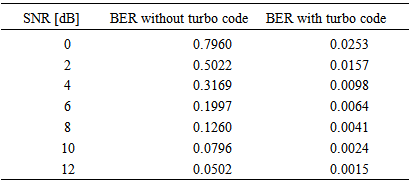 |
| |
|
Table 2. Mean Square Error (MSE) with and without Turbo code
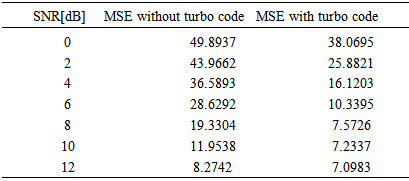 |
| |
|
Table 3. Peak Signal-to-Noise Ratio (PSNR) with and without Turbo code
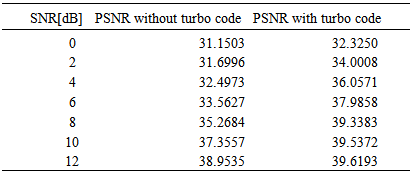 |
| |
|
In Figure 5, at SNR of 2, 4, 6 and 8, BER values of 0.0157, 0.0098, 0.0064 and 0.0041 are obtained respectively with turbo code as against 0.5022, 0.3169, 0.1997 and 0.1260 respectively without Turbo code. Figure 6 shows that the MSE values obtained at SNR 2, 4, 6 and 8dB are 43.97, 36.59, 28.63 and 19.33 respectively without Turbo code while 25.88, 16.12, 10.34 and 7.57 are MSE values obtained respectively with Turbo code measured at the same distance or point. Figure 7 depicts the PNSR values against the SNR at 2dB, 4dB, 6dB and 8dB with or without Turbo code. The 3G wireless systems with Turbo code over Rician channel give PSNR values of 34.00, 36.06, 37.99 and 39.34 at SNR of 2dB, 4dB, 6dB and 8dB respectively as against 31.70, 32.50, 33.56 and 35.27 obtained for without Turbo code respectively.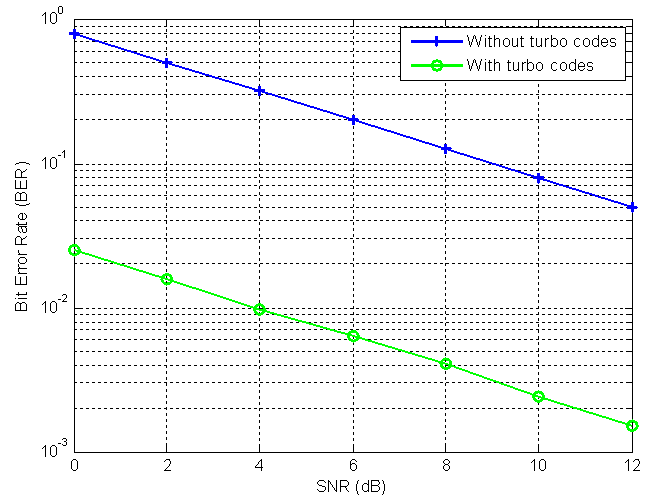 | Figure 5. Simulation of Bit Error Rate (BER) versus SNR over Rician channel of factor 10 with and without Turbo code |
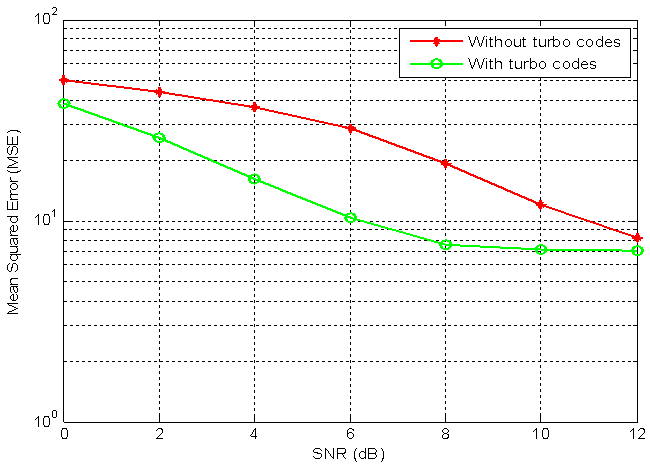 | Figure 6. Simulation of Mean Square Error (MSE) versus SNR over Rician channel of factor 10 with and without Turbo code |
 | Figure 7. Simulation of Peak Signal-to-Noise Ratio (PSNR) versus SNR over Rician channel of factor 10 with and without Turbo code |
The qualities of images received at SNR of 6dB, 12dB and 20dB with and without Turbo code receiving at the point are presented in Figures 8 (a-d).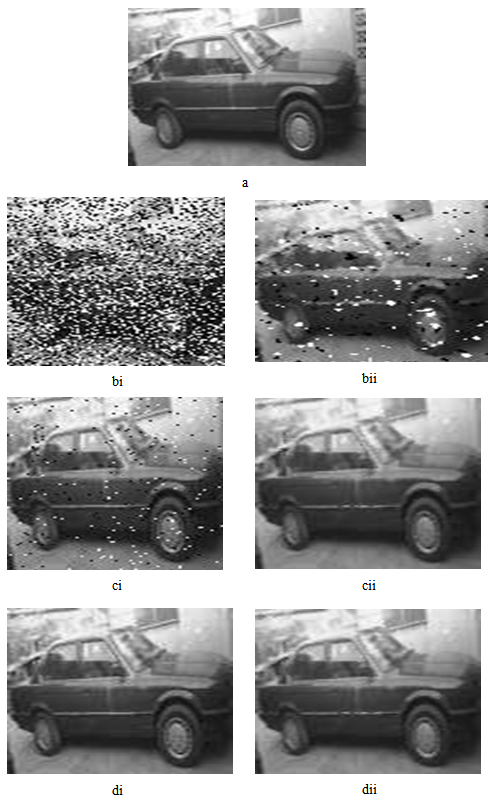 | Figure 8. a: Original image, bi: image without Turbo code at SNR of 6dB, bii: image with Turbo code at SNR of 6dB, ci: image without Turbo code at SNR of 12dB, cii: image with Turbo code at SNR of 12dB, di: image without Turbo code at SNR of 20dB, dii: image with Turbo code at SNR of 20dB |
The qualities of images received with and without Turbo code at each of these SNRs show that better qualities are obtained with Turbo code and the qualities improve as the SNR increase. These qualities are in agreement with the randomly received data.The results obtained are justifiable due to the presence of two convolutional encoders with the interleaver in between them. The first encoder scrambles the signals and reduces some of the errors and forwards them to the second encoder for further removal of error. Also, the interleaver is responsible for making two decisions uncorrelated. Some iterative decoding exploits the component-code substructure of the turbo encoder by associating a component decoder with each of the component encoders.
5. Conclusions
The effectiveness of the Turbo code in 3G wireless system over Rician fading channel has been investigated and evaluated using BER, MSE and PSNR. The system model has been developed around the Turbo encoder which consists of interleaver in between the encoders to have the iterative process. Rician fading channel with factor 10 was considered because there is dearth of information regarding this channel with Turbo code. The BER and MSE values of the 3G wireless systems with turbo code over Rician channel are lower in values compared to the one without Turbo code. While PSNR values of the system with Turbo code are higher than without the Turbo code. This has shown the effectiveness of the Turbo code in wireless system over Rician channel.
References
| [1] | Thomas, S. and Thomas, W. 2007, Mobile video transmission using SVC, IEEE Transactions on Circuits and Systems for Video Technology, 14 (4), 2-6. |
| [2] | Varundeep, K., Prasad, M.V.D., Venkatesh, D.R.G. and Arun, T. A. (2012), Study on Performance Evaluation of Reed-Solomon (RS) Codes through an AWGN Channel Model in a Communication System, International Journal of Computer Science and Communication, 3(1), 37-40. |
| [3] | Gregory, K. W. 1991, “The JPEG still picture compression standard”, Special issue on Digital multimedia systems, 34 (4), 30-44. |
| [4] | Gregory, K. W. 1991, “The JPEG still picture compression standard”, Special issue on Digital multimedia systems, 34 (2), 30-44. |
| [5] | Berrou, C., Glavieux, A. and Thitimajhima, P. 1993, “Near Shannon limit error correcting coding and decoding: turbo-codes,” Proceed of international conference communication (ICC ’93), Geneva, (2) 1064-1070. |
| [6] | B. Cellware (1998), ‘Reed-Solomon FEC submodule specifiction’. [Online]. Available: http://www.cellware.de/boards/aal1fec.html. |
| [7] | Han, Y. H. and Leou, J.J. 1998, “Detection and Correction of Transmission Errors in JPEG Images”, IEEE Transactions on Circuits and Systems for Video Technology, 8(.4), 221-231. |
| [8] | Thomas, N., Boulgouris, N.V. and Strintzis, M.G., 2005, “wireless image transmission using turbo codes and optimal unequal error protection”, IEEE Transactions on Image Processing, 14, 1890-1901. |
| [9] | Shannon, C.E. 1948, "A Mathematical Theory of Communications", Bell Systems Technical Journal, 27(2), pp.379-423. |
| [10] | Battail, G, 1998, "A conceptual framework for understanding turbo codes," IEEE Journal on Selected Areas in Communications, 16 (2), 245-254. |
| [11] | Benedetto, S. and Montorsi, G., 1996, “Design of parallel concatenated convolutional codes, IEEE Transactions on Communications, 44 (5), 591-600. |
| [12] | Dharmendra, K. S., Liam, M. and Patrick, F. (2003), “Reconfigurability of Turbo Codes for Differentiated QoS”, Limerick. |
| [13] | Andersen, J. D. and Zyablov, V. V., 1997, “Interleaver design for turbo coding,” in Proceedings of International Symposium on Turbo Codes, 54 (3),154–156. |
| [14] | Blackert, W. J., Hall, E. K., and Wilson, S. G. 1995, "Turbo code termination and interleaver conditions," Electronic Letters, 31 (24), 2082-2084. |
| [15] | Zhenyu, W., (2005), “Joint source channel coding for image transmission with JPEG200 over memoryless channels”, IEEE transactions on image processing, 14(8), 1020-1032. |
| [16] | Ramasamy, K., Mohammad, U. S. and Mohamad, Y. A., 2007, “Performance of JPEG Image Transmission Using Proposed Asymmetric Turbo Code,” EURASIP Journal on Advances in Signal Processing, 7(2), 10. |




 through the Rician channel is expressed as
through the Rician channel is expressed as
 is the received signal
is the received signal is the BPSK modulated transmitted signal
is the BPSK modulated transmitted signal  is the Rician channel
is the Rician channel  is the AWGN
is the AWGN is the number of sent bits and the FEC system adds
is the number of sent bits and the FEC system adds  redundancy bits, therefore making a total of
redundancy bits, therefore making a total of  bits sent through the transmission channel [6]. The redundancy helps the receiver to detect any error inside the received data, depending on the FEC algorithm receiver can correct the error by removal, even when a number of error is introduced during the process of transmission. Since the receiver will not ask sender for retransmission of data without querying the sender for more information, this is why it is called Forward Error Correction technique. In general, the more parity bits generated per data bit, the more potential errors can be detected and corrected [7].
bits sent through the transmission channel [6]. The redundancy helps the receiver to detect any error inside the received data, depending on the FEC algorithm receiver can correct the error by removal, even when a number of error is introduced during the process of transmission. Since the receiver will not ask sender for retransmission of data without querying the sender for more information, this is why it is called Forward Error Correction technique. In general, the more parity bits generated per data bit, the more potential errors can be detected and corrected [7]. code, and punctured to give a rate
code, and punctured to give a rate  code [8], [2].The encoders take the same data pool as input with bits ordered differently inside this data pool. At the receiver, the decoding parts use the same number and types of FEC components, placed identically. As each decoder has its own view angle and redundancy of the data, one decoder may correct some errors that other decoders have not be able to correct and vice versa. The key point of turbo code architecture is that each decoder sends its corrections to next decoder. The last decoder sends its corrections to the first one, involving an incremental and recursive correction process [9], [10], [11] [12].
code [8], [2].The encoders take the same data pool as input with bits ordered differently inside this data pool. At the receiver, the decoding parts use the same number and types of FEC components, placed identically. As each decoder has its own view angle and redundancy of the data, one decoder may correct some errors that other decoders have not be able to correct and vice versa. The key point of turbo code architecture is that each decoder sends its corrections to next decoder. The last decoder sends its corrections to the first one, involving an incremental and recursive correction process [9], [10], [11] [12].

 is the expectation value of the bit error ratio.
is the expectation value of the bit error ratio.
 is computed from the signal-to-noise ratio (SNR). The noise variance is expressed by [16] as
is computed from the signal-to-noise ratio (SNR). The noise variance is expressed by [16] as
 is the noise variance.
is the noise variance.
 represents the matrix data of our original image
represents the matrix data of our original image represents the matrix data of our degraded image
represents the matrix data of our degraded image represents the numbers of rows of pixels of the images
represents the numbers of rows of pixels of the images  represents the index of that row and
represents the index of that row and represents the number of columns of pixels of the image and
represents the number of columns of pixels of the image and  represents the index of that column
represents the index of that column


 Abstract
Abstract Reference
Reference Full-Text PDF
Full-Text PDF Full-text HTML
Full-text HTML


